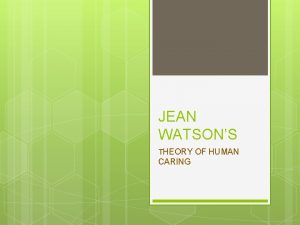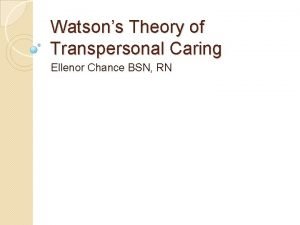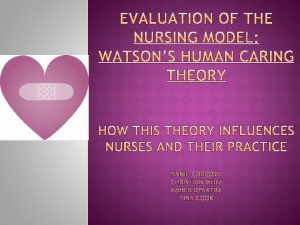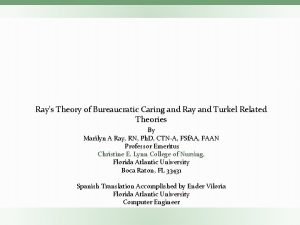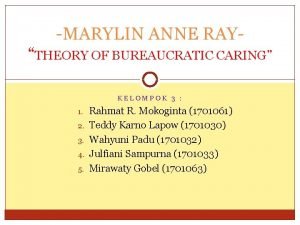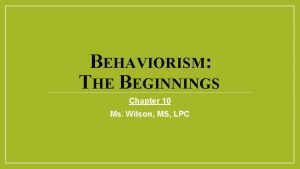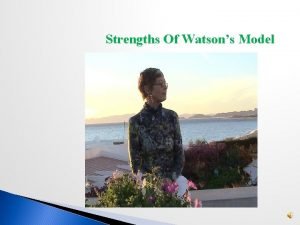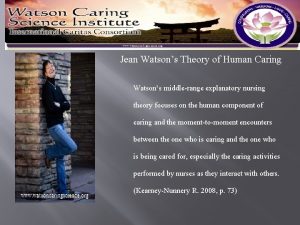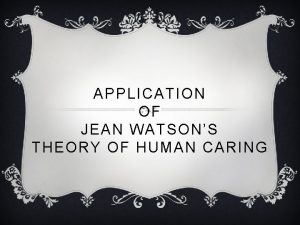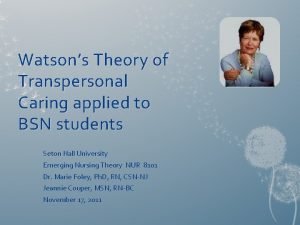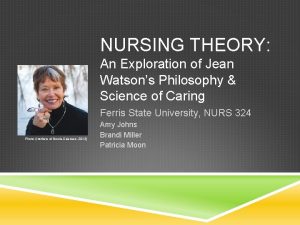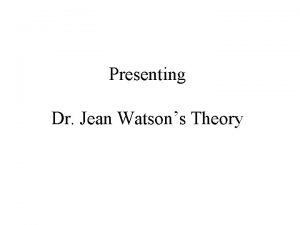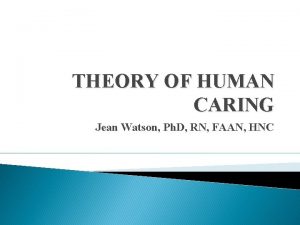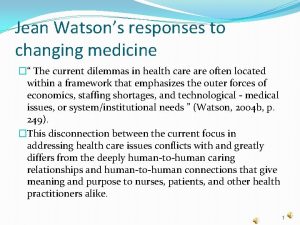Jean Watsons Theory of Human Caring Jasper Mukwada





























- Slides: 29

Jean Watson’s Theory of Human Caring Jasper Mukwada Caroline Haugen Karla Flanery Rikki Zissler

Summary of Presentation �Purpose �Bio of Jean Watson �Point of view �Information and Concepts �Watson’s Carative Factors �Uses of this theory �Research related to Watson’s theory �References �Case Study

Purpose § To introduce and critically analyze Jean Watson’s theory of Human Caring in an online discussion § Demonstrate how theory how fits in today nursing environment

Dr. Jean Watson’s Bio � She was born in West Virginia � BSN, University of Colorado, 1964 MS, University of Colorado, 1966 Ph. D, University of Colorado, 1973 Dr. Jean Watson is Distinguished Professor of Nursing and holds an endowed Chair in Caring Science at the University of Colorado Denver and Anschutz Medical Center Campus. � She is founder of the original Center for Human Caring in Colorado � She is a Fellow of the American Academy of Nursing. � Her latest activities include Founder and Director of a new non-profit foundation: Watson Caring Science Institute. � She has been Distinguished Lecturer and Endowed Lecturer at universities throughout the United States and around the world. � She holds the title of Distinguished Professor of nursing at the University of Colorado. � She has written over 14 books on caring, her latest books range from empirical measurements of caring, to new postmodern philosophies of caring and healing. � In 2008 Dr. Watson created a non-profit foundation: Watson Caring Science Institute, to further the work of Caring Science in the world. � She currently resides in Boulder, Colorado.

Point of View �Watson’s view of warmth and caring is attributed to Carl Rogers �Carl Rogers believed that “nurses are not here to manipulate others but rather to understand” Tomey, 2010). �Her theories came from her experiences and her own life. �She also believes that “caring endorses our professional identity within a context where humanistic values are constantly questioned and challenged “(Duquette &Cara, 2000).

Information and Concepts � Watson views human beings as the subject of the caring process. She states that “the nurse considers the person to be valid and whole, regardless of illness or disease” (Kearney-Nunnery, 2008). � Watson addresses this concept in one of the clinical caritas processes when she says that the nurse has to provide or create healing environments at all levels for healing to take place. These can be in the form of physical or nonphysical. üHuman Being üEnvironment

Information and Concepts Cont’d � She addresses this concepts by including the social, mental and physical functioning of the body as it relates to receptiveness of caring. � Her theory is centered on the belief that holistic health care is needed and should be practiced to provide adequate nursing. Moreover nursing is concerned with preventing illness or treating or removing the illness and restoring health. Practicing loving kindness is one of form of nursing concepts she uses to demonstrate the global concepts. üHealth üNursing

Watson’s Carative Factors �Watson views the ten factors of caring as a template for the core of nursing. �Her carative factors attempt to “honor the human dimensions of nursing’s work and the inner life world and subjective experiences of the people we serve”(Watson, 1997, p. 50) �These ten factors are listed below

The Carative Factors � Humanistic-altruistic system of value �Faith-Hope �Sensitivity to self and others �Helping-trusting, human care relationship �Expressing positive and negative feelings �Creative problem- solving caring process �Transpersonal teaching-learning �Supportive, protective, and/or corrective mental, physical, societal, and spiritual environment �Existential-phenomenological-spiritual forces �Human needs assistance (Watson, 1988, p. 75)

Clinical Caritas Processes Cont’d � Practice of loving kindness and equanimity within context of caring consciousness � Being authentically present, and enabling and sustaining the deep belief system and subjective life world of self and the one-being-cared-for. � Cultivation of one’s own spiritual practices and transpersonal self, going beyond ego self, opening to others with sensitivity and compassion. � Developing and sustaining a helping-trusting, authentic caring relationship. � Being present to, and supportive of, the expression of positive and negative feelings as a connection with deeper spirit of self and the one-being-cared-for. � Creative use of self and all ways of knowing as part of the caring process, to engage in artistry of caring-healing practices. � Engaging in genuine teaching-learning experience that attends to unity of being and meaning, attempting to stay within others’ frames of reference. � Creating healing environment at all levels (physical as well as non-physical), subtle environment of energy and consciousness, whereby wholeness, beauty, comfort, dignity, and peace are potentiated. � Assisting with basic needs, with an intentional caring consciousness, administering “human care essentials, ” which potentiate alignment of mind/body/spirit, wholeness, and unity of being in all aspects of care; tending to both the embodied spirit and evolving spiritual emergence. � Opening and attending to spiritual-mysterious and existential dimensions of one’s own life-death; soul care for self and the one-being cared for. (Watson, 2001, p. 347) �

Humanistic-altruistic system of value becomes a practice of loving and kindness and equanimity within context of caring.

Faith-Hope becomes being authentically present, and enabling and sustaining the deep belief system and subjective life world of self and the one-being -cared-for.

Cultivation of sensitivity to self and others becomes cultivation of one’s own spiritual practices and transpersonal self, going beyond ego self, opening to others with sensitivity and compassion

Developing a helping-trusting, human care relationship becomes developing and sustaining a helping-trusting, authentic caring relationship.

Expressing positive and negative feelings becomes being present to, and supportive of the expression of positive and negative feelings as a connection with deeper spirit of self and the one-being-cared-for

Creative problem- solving caring process becomes creative use of self and all ways of knowing as part of the caring process, to engage in artistry of caring and healing practices.

Promotion of transpersonal teachinglearning becomes engaging in genuine teaching-learning experience that attends to unity of being and meaning attempting to stay within other's frame of reference

Supportive, protective, and/or corrective mental, physical, societal, and spiritual environment becomes creating healing environment at all levels, (physical as well as nonphysical, subtle environment of energy and consciousness, whereby wholeness, beauty, comfort, dignity, and peace are potentiated

Assistance with gratification of human needs becomes assisting with basic needs, with an intentional caring consciousness, administering ‘human care essentials', which potentiate alignment of mind-bodyspirit, wholeness, and unity of being in all aspects of care

Clinical Caritas Processes Watson continued to evolve these concepts of her theory, and then introduced a new concept of clinical caritas processes. These processes have now replaced her former carative factors.

Transpersonal Caring Relationship �She believed that for caring to happen in an authentic way, the one being cared for and the care giver should have a mutual respect for one another. �When this relationship is allowed to bloom, patients often have a better turn around in their health status

Uses of this Theory _ �This model is used everywhere in healthcare. � It is used in OB, OR community nursing and anywhere there is a patient. �The concepts are easy to understand because they are plain and follow a chronologic order.

Caring Occasion/Caring Moment �According to Watson (1988, 1999), a caring occasion is the moment (focal point in space and time) when the nurse and another person come together in such a way that an occasion for human caring is created. The nurse has to also be conscious of her presence in this moment and her interaction with the patient.

Research related to Watson’s theory � Saint Joseph Hospital in Orange, California has selected Jean Watson’s theory of human caring as the framework base for nursing practice, (Current Nursing, 2010) � The effectiveness of Watson's Caring Model on the quality of life and blood pressure of patients with hypertension. J Adv Nursing. 2003 Jan; 41(2): 130 -9. � This study demonstrated a relationship between care given according to Watson's Caring model and increased quality of life of the patients with hypertension. Further, in those patients for whom the caring model was practiced, there was a relationship between the Caring model and a decrease in patient's blood pressure. The Watson Caring Model is recommended as a guide to nursing patients with hypertension, as one means of decreasing blood pressure and increase in quality of life. (Current Nursing, 2010) � Mullaney, J. A. B. (2000). The lived experience of using Watson’s actual caring occasions to treat depressed women. Journal of Holistic Nursing, 18(2), 129142 � Martin, L. S. (1991). Using Watson’s theory to explore the dimensions of adult polycystic kidney disease. ANNA Journal, 18, 403 -406 (Current Nursing, 2010)

Case Study A 24 year old woman G 1 P 1 now who is single has just delivered a 24 week gestation infant. This is her first child and she is unmarried and is not involved in a relationship with the father of the baby. Her only support person is her mother since the patient is originally from out of state and was here visiting her mother for the holiday season. The patient’s mother will be her support person during this new family event unfortunately the patients mother is not able to be with her that often due to work and other outside activities she is involved in.

Case study continued After receiving report you start your day. As you walk into your patient’s room she is sitting up in the bed and crying. You assess her and find out that she is crying due to her newly born infant is not “doing very well”. 1. What are 3 carative factors of Jean Watson’s theory that you can apply to your situation explain why you chose them as your personal factors you would use. 2. Out of the 4 informational concepts, which one is most affected this patient.

Key to case study Answer to 1. In any order any of these could be addressed with a reasonable explanation of why one may feel the carita is necessary. � Cultivation of sensitivity to self and others � Developing a helping-trusting human care relationship � Humanistic-altruistic system of value � Expressing positive and negative feelings � Supportive, protective, and/or corrective mental, physical, societal, and spiritual environment � Assistance with gratification of human needs Answer to 2. Nursing was affected due to the patient needing emotional and spiritual support.

References Alligood, M. R. & Tomey, A. M. (2010). Nursing Theorists and Their Work (7 th ed. ) St. Louis, MO: Mosby Elsevier Duguette, A. &Cara, C. (2000). Le caring et la santé de l’infirmiere. L’infirmiere Canadienne, 1(2), 10 -11. Foster, R. L. (2006). A perspective on Watson’s theory of human caring. Nursing Science Quarterly, 19(40: 332 -333. Retrieved from http: //nsq. sagepub. com/content/19/4/332 Kearney-Nunnery, R. (2008). Advancing your career: Concepts of professional nursing. (4 th ed. ) Philadelphia, PA: F. A. Davis Mitchell, G. (2002). Learning to practice the Discipline of Nursing Science Quarterly. 15(3), 209 -213 doi: 10. 1177/08918402015003006 Right, J. (2010). How to integrate Jean Watson's theory of caring into nursing practice. Retrieved November 12, 2010, from: http: //www. ehow. com/how_6644521_intergrate-theory-caring-nursing-practice. html Watson, J. (1997). Theory of human caring: Retrospective and prospective. Nursing Science Quarterly, 10(1), 49 -52. Watson, J. (1988). Nursing: Human science and human care. A theory of nursing (2 nd printing). New York: National League for Nursing. Watson, J. (1997). Theory of human caring: Retrospective and prospective. Nursing Science Quarterly, 10(1), 49 -52. Watson, J. (1999). Postmodern nursing and beyond. Toronto, Canada: Churchill Livingstone. Watson, J. (2001). Jean Watson: Theory of human caring. Nursing theories and nursing practice, 343 -354. Philadelphia: Davis. http: //www. ana. org http: //caring. org http: //currentnursing. com/nursing_theory/Watson. html http: //www. watsoncaringscience. org/index. html

Thank you from Jasper, Rikki, Caroline, and Karla!
 Dr jean watson
Dr jean watson Examples of jean watson's theory in practice
Examples of jean watson's theory in practice Theory of transpersonal caring
Theory of transpersonal caring Caring is the essence of nursing jean watson
Caring is the essence of nursing jean watson Jean watson caring moment
Jean watson caring moment Marilyn anne ray theory
Marilyn anne ray theory Nursing as caring theory by boykin & schoenhofer
Nursing as caring theory by boykin & schoenhofer Teori marilyn anne ray
Teori marilyn anne ray Jean monnet jean-gabriel monnet
Jean monnet jean-gabriel monnet Jean omer marie gabriel monnet
Jean omer marie gabriel monnet The watsons go to birmingham vocabulary chapters 1-4
The watsons go to birmingham vocabulary chapters 1-4 The watsons go to birmingham chapter 8
The watsons go to birmingham chapter 8 The watsons go to birmingham kenny
The watsons go to birmingham kenny Tt ab 700 ultra glide
Tt ab 700 ultra glide True-tone ab-700 model ultra glide
True-tone ab-700 model ultra glide John watson theory of behaviorism
John watson theory of behaviorism Doc watsons toledo
Doc watsons toledo Strengths and weaknesses of watson's theory
Strengths and weaknesses of watson's theory Mr watsons
Mr watsons Watsons go to birmingham chapter 4
Watsons go to birmingham chapter 4 Why was the watsons go to birmingham banned
Why was the watsons go to birmingham banned Meet the watsons
Meet the watsons The watsons go to birmingham conflict
The watsons go to birmingham conflict Who died in the watsons go to birmingham
Who died in the watsons go to birmingham The watsons go to birmingham one pager
The watsons go to birmingham one pager Notice and note strategies
Notice and note strategies Keen coleman
Keen coleman Jasper woodbury
Jasper woodbury Jasper private equity
Jasper private equity Ikea jasper
Ikea jasper

